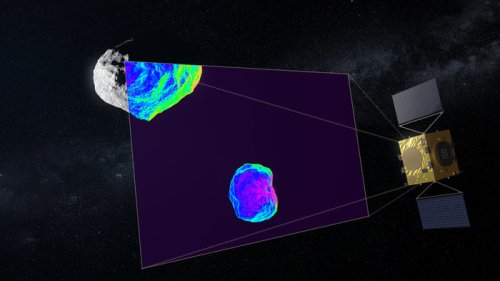ESA and NASA are testing defenses against an asteroid threat:
Earth’s first mission to a binary asteroid,
for planetary defence

25 June 2018: Planning for humankind’s first mission to a binary asteroid system has entered its next engineering phase. ESA’s proposed Hera mission would also be Europe’s contribution to an ambitious planetary defence experiment.
Named for the Greek goddess of marriage, Hera would fly to the Didymos pair of Near-Earth asteroids: the 780 m-diameter mountain-sized main body is orbited by a 160 m moon, informally called ‘Didymoon’, about the same size as the Great Pyramid of Giza.
“Such a binary asteroid system is the perfect testbed for a planetary defence experiment but is also an entirely new environment for asteroid investigations. Although binaries make up 15% of all known asteroids, they have never been explored before, and we anticipate many surprises,”
explains Hera manager Ian Carnelli.
“The extremely low-gravity environment also presents new challenges to the guidance and navigation systems. Fortunately we can count on the unique experience of ESA’s Rosetta operations team which is an incredible asset for the Hera mission.”
The smaller Didymoon is Hera’s main focus: the spacecraft would perform high-resolution visual, laser and radio science mapping of the moon, which will be the smallest asteroid visited so far, to build detailed maps of its surface and interior structure.
By the time Hera reaches Didymos, in 2026, Didymoon will have achieved historic significance: the first object in the Solar System to have its orbit shifted by human effort in a measurable way.
A NASA mission called the Double Asteroid Redirection Test, or DART, is due to collide with it in October 2022. The impact will lead to a change in the duration of Didymoon’s orbit around the main body. Ground observatories all around the world will view the collision, but from a minimum distance of 11 million km away.
“Essential information will be missing following the DART impact – which is where Hera comes in,” adds Ian. “Hera’s close-up survey will give us the mass of Didymoon, the shape of the crater, as well as physical and dynamical properties of Didymoon.
“This key data gathered by Hera will turn a grand but one-off experiment into a well-understood planetary defence technique: one that could in principle be repeated if we ever need to stop an incoming asteroid.”
The traditional method of estimating the mass of a planetary body is to measure its gravitational pull on a spacecraft. That is not workable within the Didymos system: Didymoon’s gravitational field would be swamped by that of its larger partner.

Instead, Hera imagery will be used to track key landmarks on the surface on the bigger body, ‘Didymain’, such as boulders or craters. By measuring the ‘wobble’ Didymoon causes its parent, relative to the common centre of gravity of the overall two-body system, its mass could be determined with an accuracy over 90%.
Hera will also measure the crater left by DART to a resolution of 10 cm, accomplished through a series of daring flybys, giving insight into the surface characteristics and internal composition of the asteroid.
“Hera benefits from more than five years of work put into ESA’s former Asteroid Impact Mission,” comments Ian. “Its main instrument is a replica of an asteroid imager already flying in space – the Framing Camera used by NASA’s Dawn mission as it surveys Ceres, which is provided by the German Aerospace Center, DLR.
“It would also carry a ‘laser radar’ lidar for surface ranging, as well as a hyperspectral imager to characterise surface properties. In addition, Hera will deploy Europe’s first deep space CubeSats to gather additional science as well as test advanced multi-spacecraft intersatellite links.”
NASA’s DART mission meanwhile has passed its preliminary design review and is about to enter its ‘Phase C’ detailed design stage.

=====


